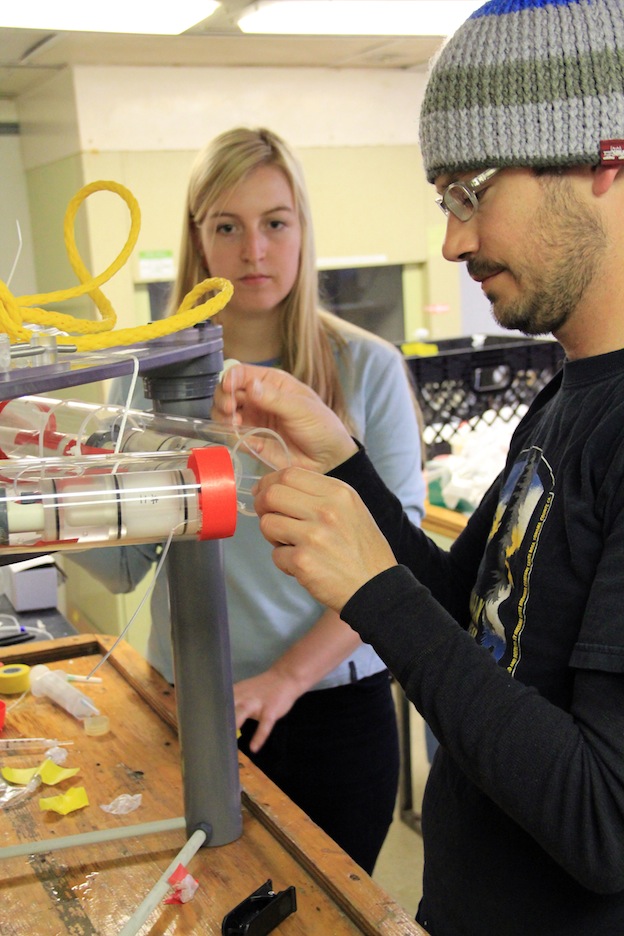Most of today was spent in transit from the primary node test site to a site off Gray’s Harbor, WA to recover a NSF Cascadia Array Initiative ocean bottom seismometer (OBS). Once we rounded the J-buoy and were out of the Strait of Juan de Fuca, we briefly stopped for a plankton net tow and then continued south with the EM302 and 3.5 kHz echosounder systems running for mapping purposes. When the ship arrived at the seismometer site, the instrument was interrogated from the ship to determine its relative position. ROPOS was then lowered for dive 1457 to retrieve the OBS. The dive took about 3 hours and the ROPOS and Thompson crew members were able to successfully get the OBS on board. After the recovery at 11:45 PDT, the Thompson began the ~11 hour transit to Hydrate Ridge with the EM302 system surveying.
In addition to the scientific operations, the VISIONS’11 expedition is also providing a complete immersion experience for undergraduate and graduate students on board. Four students are participating in Leg 1 of this research cruise and seven more will join us in Newport, OR on August 19th during the port stop. Throughout the cruise, the students will work alongside experienced scientists, engineers, and the ship’s crew to gain at-sea research experience. Using the ROV ROPOS and oceanographic equipment they will conduct their own research and data collection, which you can read about on their student pages. Below are first impressions from two University of Washington undergraduate students on the first few days of their first research cruise.
Lexi Brewer, UW senior
After two full days, I'm just starting to get acclimated to shipboard life. Based on warnings from those in the know, I'd been bracing myself for seasickness now that we're through the Strait. Luckily conditions are good so I'm not getting bounced around like I thought I would, and I don't seem to have any problems with the ship's gentle rolling. Instead of seasick, I just feel discombobulated. Attempting to live on something that isn't stationary feels like someone has taken the world and rotated it about 10 degrees off kilter. The little things, like getting dressed in the morning, or taking a shower, or even just sitting on a stool and typing this don't feel routine like they should, I suspect because a large chunk of my brain is now entirely tied up with keeping me vertical.
Everyone on the ship is incredibly busy getting ready for the research we'll do at Hydrate Ridge. I've spent a good few hours over the past two days as an extra set of arms helping Evan set up his flow meters, which involved a lot of troubleshooting on his part and holding of various plastic tubes on mine. We're expected to arrive in Gray's Harbor at around 21:00, which will be in the middle of my watch, so I might get to witness ROPOS in action when it retrieves the seismometer, though hopefully conditions won't be like they were last night and I'll see more than a just a screen full of marine snow.
Cody Turner, UW sophomore
So far, this research cruise has been both educational and fun. It is interesting to see how operations are run on the Thompson, and how the engineers, scientists, and the crew of the Thompson all work together. It was especially cool to see how the operators of the ROV are able to control the vehicle so precisely. We just sailed into open ocean today, and the waves are fairly calm so I haven’t felt seasick at all (woohoo!). I will be starting my research as soon as we reach Hydrate Ridge. As of now, I will be taking water samples from the CTD casts and analyzing them using a gas chromatograph to determine the concentration of methane. I will use a microscope to determine how many and what kind of microbes are in the samples. I will also look at data given by the EM 302, which gives a general idea of the size and shape of a bubble plume. All this is to examine the relationship between methane in bubble plumes and the microbiology within the water column.





